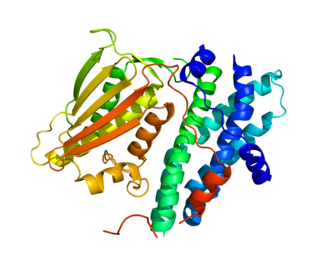
Pyruvate dehydrogenase lipoamide kinase isozyme 1, mitochondrial is an enzyme that in humans is encoded by the PDK1 gene. It codes for an isozyme of pyruvate dehydrogenase kinase (PDK).

Ferrocyanide is the name of the anion [Fe(CN)6]4−. Salts of this coordination complex give yellow solutions. It is usually available as the salt potassium ferrocyanide, which has the formula K4Fe(CN)6. [Fe(CN)6]4− is a diamagnetic species, featuring low-spin iron(II) center in an octahedral ligand environment. Although many salts of cyanide are highly toxic, ferro- and ferricyanides are less toxic because they tend not to release free cyanide. It is of commercial interest as a precursor to the pigment Prussian blue and, as its potassium salt, an anticaking agent.

Cytochromes b5 are ubiquitous electron transport hemoproteins found in animals, plants, fungi and purple phototrophic bacteria. The microsomal and mitochondrial variants are membrane-bound, while bacterial and those from erythrocytes and other animal tissues are water-soluble. The family of cytochrome b5-like proteins includes hemoprotein domains covalently associated with other redox domains in flavocytochrome cytochrome b2, sulfite oxidase, plant and fungal nitrate reductases, and plant and fungal cytochrome b5/acyl lipid desaturase fusion proteins.
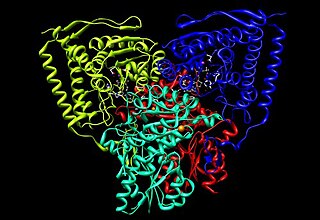
Pyruvate dehydrogenase is an enzyme that catalyzes the reaction of pyruvate and a lipoamide to give the acetylated dihydrolipoamide and carbon dioxide. The conversion requires the coenzyme thiamine pyrophosphate.
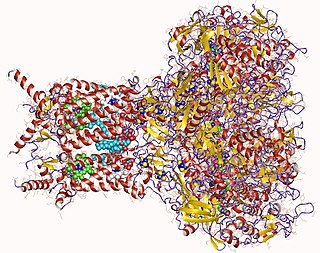
Formate dehydrogenases are a set of enzymes that catalyse the oxidation of formate to carbon dioxide, donating the electrons to a second substrate, such as NAD+ in formate:NAD+ oxidoreductase (EC 1.17.1.9) or to a cytochrome in formate:ferricytochrome-b1 oxidoreductase (EC 1.2.2.1). This family of enzymes has attracted attention as inspiration or guidance on methods for the carbon dioxide fixation, relevant to global warming.

In enzymology, a sulfite dehydrogenase (EC 1.8.2.1) is an enzyme that catalyzes the chemical reaction
In enzymology, a D-2-hydroxy-acid dehydrogenase is an enzyme that catalyzes the chemical reaction
In enzymology, a D-lactate dehydrogenase (cytochrome) is an enzyme that catalyzes the chemical reaction
In enzymology, a D-lactate dehydrogenase is an enzyme that catalyzes the chemical reaction
In enzymology, a carbon-monoxide dehydrogenase (cytochrome b-561) (EC 1.2.2.4) is an enzyme that catalyzes the chemical reaction
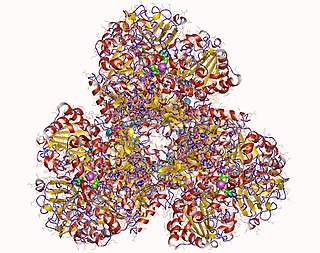
In enzymology, a formate dehydrogenase (cytochrome) (EC 1.2.2.1) is an enzyme that catalyzes the chemical reaction
In enzymology, a formate dehydrogenase (cytochrome-c-553) (EC 1.17.2.3) is an enzyme that catalyzes the chemical reaction
In enzymology, a pyruvate dehydrogenase (cytochrome) (EC 1.2.2.2) is an enzyme that catalyzes the chemical reaction
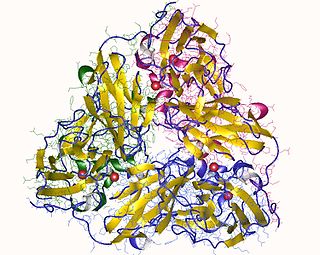
In enzymology, a nitrite reductase (NO-forming) (EC 1.7.2.1) is an enzyme that catalyzes the chemical reaction

Lactate dehydrogenase (LDH or LD) is an enzyme found in nearly all living cells. LDH catalyzes the conversion of pyruvate to lactate and back, as it converts NAD+ to NADH and back. A dehydrogenase is an enzyme that transfers a hydride from one molecule to another.
Polyvinyl alcohol dehydrogenase (cytochrome) (EC 1.1.2.6, PVA dehydrogenase, PVADH) is an enzyme with systematic name polyvinyl alcohol:ferricytochrome-c oxidoreductase. This enzyme catalyses the following chemical reaction
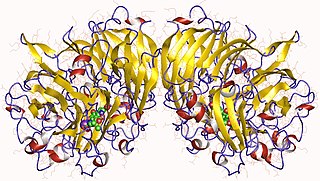
Methanol dehydrogenase (cytochrome c) (EC 1.1.2.7, methanol dehydrogenase, MDH) is an enzyme with systematic name methanol:cytochrome c oxidoreductase. This enzyme catalyses the following chemical reaction
L-galactonolactone dehydrogenase (EC 1.3.2.3, galactonolactone dehydrogenase, L-galactono-gamma-lactone dehydrogenase, L-galactono-gamma-lactone:ferricytochrome-c oxidoreductase, GLDHase, GLDase) is an enzyme with systematic name L-galactono-1,4-lactone:ferricytochrome-c oxidoreductase. This enzyme catalyses the following chemical reaction
Lupanine 17-hydroxylase (cytochrome c) (EC 1.17.2.2, lupanine dehydrogenase (cytochrome c)) is an enzyme with systematic name lupanine:cytochrome c-oxidoreductase (17-hydroxylating). This enzyme catalyses the following chemical reaction
The lactate shuttle hypothesis describes the movement of lactate intracellularly and intercellularly. The hypothesis is based on the observation that lactate is formed and utilized continuously in diverse cells under both anaerobic and aerobic conditions. Further, lactate produced at sites with high rates of glycolysis and glycogenolysis can be shuttled to adjacent or remote sites including heart or skeletal muscles where the lactate can be used as a gluconeogenic precursor or substrate for oxidation. The hypothesis was proposed in 1985 by George Brooks of the University of California at Berkeley.










